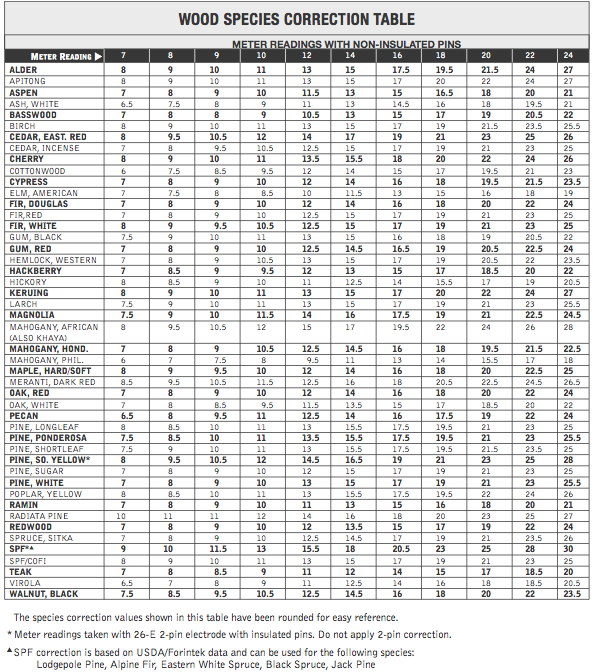When you use a wood moisture meter, it is calibrated to provide accurate measurements of moisture content in one specific type of wood. For Delmhorst’s wood moisture meters, the calibration used is for Douglas Fir wood. If used for another species of wood—such as eastern red cedar, the meter’s moisture measurements would not be accurate.

Why?
Different kinds of wood have different physical properties for electrical resistance and specific gravity (SG). Pin meters use the principle of electrical resistance to measure the moisture content (%MC) of wood. Since wood is a resistor and water is a conductor, more resistance equals less water, and vice versa. However, if the wood is inherently more or less resistant to electricity than the species the moisture meter for wood was calibrated for, this will throw off the reading results.
Pinless meters use electromagnetic radio waves to scan wood materials. If the wood has a higher or lower specific gravity than the type of wood the meter is calibrated for, this can affect the accuracy of the reading.
To overcome this issue and record accurate moisture measurements in wood materials, it is important to perform what is known as a species correction. Making species corrections helps you to adjust the readings your moisture meter provides to get a more accurate measurement of moisture in wood.
Some high-quality moisture meters, such as Delmhorst’s ProScan pinless moisture meter and Delmhorst’s J-2000 pin meter have built-in species correction settings. Simply punch in the right wood species and start taking readings like normal, and the meter will do the rest of the work for you!
However, if you don’t have a wood moisture meter with built-in species corrections, you’ll have to make the adjustments yourself. Here’s a quick rundown of how to manually make species corrections:
Using a Pin Meter Species Correction Table
Some manufacturers have a species correction table for their moisture meter products that you can use to quickly make adjustments. These tables typically list a few common wood species and the corrections you should apply to several different reading values over a detection range typical of that manufacturer’s moisture meters.
For example, in Delmhorst’s own species correction table for pin meters, if you look up eastern red cedar, you’ll see that if your Delmhorst meter is reading 7% MC, then you should record 8% MC as the actual moisture content of that wood sample. Meanwhile, a reading of 14% MC should be recorded as 17% MC.
Making Species Corrections for Pinless Wood Moisture Meters
What about pinless moisture meters? Here, Delmhorst offers an online reading adjustment tool that you can use to make species corrections. Simply plug in the meter reading and the specific gravity (SG) of the wood being measured and it will give you a corrected moisture content value for that reading. Below the calculator is a list of different wood species and their specific gravity values so you can find the right SG value to plug into the calculator.
It is important to note that these correction tables and calculators are manufacturer-specific. This means that if you were to use a Delmhorst correction table for a different company’s moisture meters, the results would not be accurate. This is because different moisture meters made by different manufacturers are calibrated to different standards.
Additional Corrections to Consider
Moisture meters for wood may need to correct for things other than the species of wood being tested. For example, pin meters may need to have corrections made for the type of pins being used and for the temperature of the wood.
Temperature can affect the electrical conductivity of the wood itself. Over the range of 50 to 90 degrees Fahrenheit (10 to 32.2 degrees Celsius), there isn’t much impact on reading results. However, outside of this temperature range, higher temperatures can increase indicated moisture, while lower temperatures can decrease indicated moisture. Pinless wood moisture meter readings aren’t typically affected by temperature unless the wood is frozen solid.
Meanwhile, insulated pins typically read slightly lower than their uninsulated counterparts. So, if the moisture meter you’re using doesn’t adjust for this difference, you will have to adjust the readings manually. On a Delmhorst moisture meter, the reading difference between insulated and uninsulated pins is about 5% of the reading’s value—though there is some fluctuation as readings get higher.
For example, as noted in our pin correction table, a reading of 8% MC would actually indicate 8.4% MC when using insulated pins, and a reading of 16% MC would indicate 17% MC.
When making species corrections for a pin meter in wood that is at a higher or lower temperature than normal, you’ll have to make both sets of corrections.
Need to know more about measuring moisture in wood? Check out the guide at the link below, or contact us today!

Comments